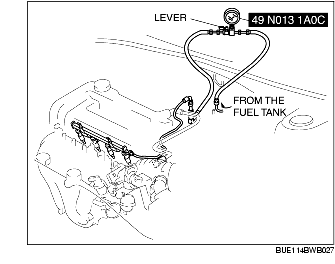
1. Perform the 'Fuel Line Safety Procedure' referring to the BEFORE SERVICE PRECAUTION. (See BEFORE SERVICE PRECAUTION [L3].)
2. Disconnect the negative battery cable.
3. Disconnect the quick release connector of the engine compartment side. (See QUICK RELEASE CONNECTOR REMOVAL/INSTALLATION [L3].)
4. Turn the lever of the SST parallel to the hose as shown in the figure.
5. Insert the SST quick release connector into the fuel pipe until a click is heard.
6. Verify that the installation is secure by pulling the quick release connector.
7. Verify that the selector lever is in the N range, and start the engine.
8. Measure the fuel line pressure while idling.
9. Observe the fuel pressure gauge indicator during heavy acceleration.
10. Turn the ignition switch to the LOCK position.
11. Measure the fuel hold pressure after 5 min.
12. Perform the 'Fuel Line Safety Procedure' referring to the BEFORE SERVICE PRECAUTION [L3]. (See BEFORE SERVICE PRECAUTION [L3].)
13. Disconnect the SST.
14. Connect the quick release connector. (See QUICK RELEASE CONNECTOR REMOVAL/INSTALLATION [L3].)
15. Inspect all parts by performing the AFTER SERVICE PRECAUTION. (See AFTER SERVICE PRECAUTION [L3].)